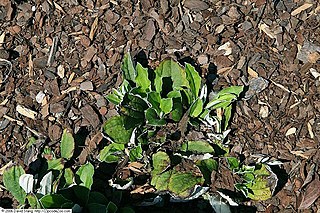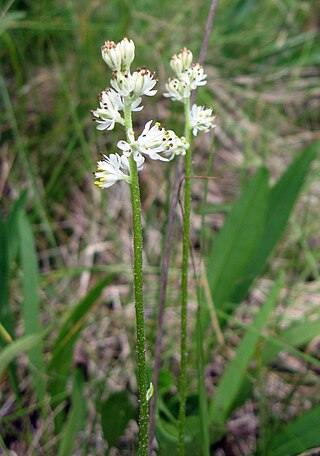
Antennaria is a genus of dioecious perennial herbs in the family Asteraceae, native to temperate regions of the Northern Hemisphere, with a few species in temperate southern South America; the highest species diversity is in North America. Common names include catsfoot or cat's-foot, pussytoes and everlasting.

Antennaria argentea is a North American species of flowering plants in the family Asteraceae known by the common name silver pussytoes or silvery everlasting. It is native primarily to Oregon and to northern and central California with additional populations in Nevada, Idaho, Montana, and Washington.

Antennaria corymbosa is a North American species of flowering plants in the family Asteraceae known by the common names flat-top pussytoes or meadow pussytoes. It is native to western Canada and the Western United States south as far as Tulare County in California and Rio Arriba County in New Mexico. It grows in moist, cool areas such as mountain meadows and riverbanks. Most of the populations are found in the Rocky Mountains, the Cascades, and the Sierra Nevada.

Antennaria racemosa is a species of flowering plant in the family Asteraceae known by the common name racemose pussytoes. It is native to western North America from British Columbia and Alberta south as far as northern California and Wyoming. It grows in mountain forests, generally in moist, partially shaded areas, and often colonizes bare patches of mineral-rich soil, including disturbed areas.

Antennaria rosea is a North American species of flowering plant in the family Asteraceae known by the common name rosy pussytoes. Other common names include cat's foot and mountain everlasting. The second part of its scientific name, rosea, is Latin for pink.

Antennaria umbrinella is a North American species of flowering plants in the family Asteraceae known by the common names umber pussytoes and brown pussytoes. It is native to southwestern Canada and the western United States as far south as Colorado, Coconino County in Arizona, and Tulare County in California). It grows in a variety of habitats at a variety of elevations, from lowland sagebrush steppe to subalpine meadows.

Rhamnus alnifolia is a species of flowering plant in the buckthorn family known by the common names alderleaf buckthorn, or alder buckthorn. Unlike other "buckthorns", this alder buckthorn does not have thorns. It is native to North America, where it is known mainly from the southern half of Canada and the northern half of the United States and California. It can be found in forested habitat.

Antennaria parvifolia is a species of flowering plant in the family Asteraceae, known by the common names small-leaf pussytoes and Nuttall's pussytoes. It is native to western and central North America.

Antennaria plantaginifolia is a perennial forb native to the eastern North America, that produces cream colored composite flowers in spring.

Antennaria lanata is a North American species of flowering plant in the family Asteraceae, known by the common name woolly pussytoes. It is native to western Canada and the northwestern United States.

Antennaria monocephala, the pygmy pussytoes, is a flowering plant in the family Asteraceae. It is native to arctic and alpine regions of North America as well as the Chukotka (Chukchi) Peninsula of Russia.

Antennaria parlinii is a North American species of flowering plants in the family Asteraceae known by the common name Parlin's pussytoes. It is widespread across eastern and central Canada and eastern and central United States, from Manitoba to Nova Scotia south as far as Texas and Georgia.
Antennaria pulchella is a North American species of flowering plants in the family Asteraceae known by the common names showy pussytoes and handsome pussytoes. It is widespread across much of Canada including the three Arctic Territories, as well as in parts of the United States.

Antennaria solitaria is a North American species of flowering plant in the family Asteraceae known by the common name singlehead pussytoes. It is found in the southeastern and east-central part of the United States from Delaware and southern Pennsylvania west to southern Illinois and south as far as Georgia and Louisiana.

Antennaria stenophylla is a North American species of flowering plants in the family Asteraceae known by the common name narrowleaf pussytoes. It is native to the Great Basin, Columbia Plateau, and Snake River Plain of the Western United States, in the States of Washington, Oregon, Idaho, Nevada, and Utah.

Crepis nicaeensis is a European species of flowering plant in the family Asteraceae with the common names French hawk's-beard and Turkish hawksbeard. It is widespread across much of Europe, as well as being sparingly naturalized in scattered locations in the United States and Canada.

Solidago uliginosa, or bog goldenrod, is a North American species of flowering plants in the family Asteraceae. It is found in eastern Canada and the eastern United States.

Polygonum oxyspermum is a coastal species of flowering plant in the buckwheat family. It is native to Europe, primarily along the shores of the Atlantic, the North Sea, and the Baltic Sea, from France and Ireland to Finland and Russia. It is also naturalized in eastern Canada and in the US State of Maine.

Rubus setosus, the bristly blackberry, is a North American species of flowering plant in the rose family. It is widespread in much of central and eastern Canada and the northeastern and north-central United States

Triantha glutinosa is a species of flowering plant in the Tofieldiaceae family. It is commonly known as the sticky false asphodel, sticky tofieldia or northern bog asphodel, is a species of flowering plant in the tofieldia family.




















